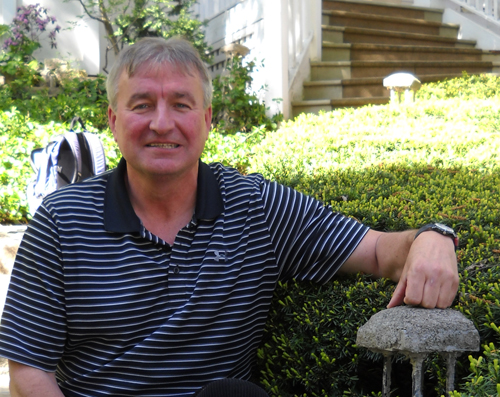
A lot has happened at John Reinhart’s house since the last time his garden appeared in the annual Guelph Gardenscapes tour. It was back in 2002 that his “house on the hill” was included in the annual fundraiser for the Macdonald Stewart Art Centre (MSAC). Two years later, the entire house burned down, taking a few trees and other plants with it.
The house has been rebuilt. And visitors during this weekend’s Gardenscapes tour will find the garden as full and lush as if it had been here forever. Reinhart, long-time U of G grounds manager, had the place rebuilt around surviving landscape features, including limestone pathways and patios, a stone fireplace and garden walls.
Most of the tall trees on the Dufferin Street property pulled through as well. Now they form a canopy front and back. “The whole place is covered with a ceiling of trees,” says Reinhart.
One reminder of the blaze is that big old American ash out back, with a few stunted limbs poking out from among its normal branches. Still, most visitors this Sunday will likely see no clue to the decade-old disaster.
Instead, they’ll see what Reinhart calls a “gardener’s garden,” a landscape of stone and perennial greenery suited for the shade.
By day, Reinhart oversees gardens and green spaces on the campus grounds. After-hours, he puts his two U of G horticulture degrees to use in looking after his extensive home garden.
Don’t look for expansive lawns or ordinary plantings here. Yes, his garden includes tulips and dogwood and forsythia shrubs and other fare known to many gardeners, and even to non-gardeners, but Reinhart has painted with a more exotic palette, including some 300 distinct species from trees to moss.
Woody spirea, redbud, Japanese maple, calycanthus, firethorn, silverlace vine, wisteria: all kinds of shrubs and vines grow here, interspersed with numerous perennials, including hostas, buttercups, hellebores, peonies, holly, lily of the valley and leatherleaf ferns.
He’s got “one of the biggest boxwoods you’ll see in town.” Even his forsythia is off-kilter, its blooms an unusual white rather than the normal yellow. A witch hazel called ‘Arnold Promise’ flowered in early March even with its feet buried under a foot of snow.
Surveying the greenery blanketing the entire front of the property, he says, “The average person wouldn’t do this. It’s more of a gardener’s garden.”
Spring fanfare in Reinhart’s garden involved some 3,000 flowering bulbs, including a few tulips but mostly less common bloomers: grape hyacinths, Puschkinia, Chionodoxa and Scilla.
Most of his alliums are blooming now, their long leafless stalks and round floral umbels making them look like choirs of lollipops. This is his favourite time in the garden: “Everything is so vibrant and coming along.”
Trim yew hedges line the limestone steps rising from the street. Spaced throughout are Reinhart’s homemade concrete light fixtures, almost 20 in all, each knee-high and Middle Earth-ish.
Also dotted around the property are stone and metal containers, most too big to wrap your arms around. He packs the whimsical planters with annuals, including begonias and impatiens – anything that tolerates shade.
Elsewhere are rhino-shaped topiary forms (“My friends used to call me Rhino”), ponds, a massive backyard fireplace, stone patios and flagstone pathways. “Stone and plants, those are my true loves – and my wife.”
Reinhart spends some 10 hours a week tending the garden. His wife, Ellen, helps with watering and advice. They have three sons: Jake, Job and Will.
When Job was 10, he used to accompany Dad around the garden, rhyming off plants’ Latin names with no more effort than lobbing two-pointers in the basketball court in the former alley beyond the back gate. Six years later, Job and his brothers are more interested in football than flora.
John Reinhart was in his mid-teens and living at his parents’ home just a few blocks along Dufferin when he started gardening. “I was obsessed from the time I was 15.”
That was when he started working part-time on the University grounds. His dad, Bert Reinhart, taught animal sciences on campus until retiring in 1985. John took his passion to the family cottage, ripping apart the garden and then rebuilding it. “I never considered doing anything else.”
His favourite plant? Rooted about 300 million years ago, ginkgo belongs to non-flowering plants, but Reinhart says the ancestors of flowering plants, or angiosperms, came from gymnosperms such as ginkgo. “It sent everything on its way 100 million years ago.”
And it’s still here, through all the eons of ice and fire.
The Reinhart property is one of 10 Guelph gardens in this year’s Gardenscapes. The self-guided tour will take place June 9 from noon to 6 p.m. For more information, call 519-837-0010 or visit www.msac.ca.
[slideshow gallery_id=”9″]